Blog: The Million Dollar Case Study Session #3: How To Find An Alibaba Supplier
The Million Dollar Case Study Session #3: How To Find An Alibaba Supplier
“Ideas are easy. Execution is everything. It takes a team to win.” – John Doerr, Venture Capitalist, Kleiner Perkins
We now have an idea of the product that we will sell for our Million Dollar Case Study: hooded baby towels or magnetic tiles for kids. But these are just ideas… the execution begins now!
Specifically, where can we find a trustworthy partner to manufacture an excellent product that allows us to differentiate from the existing competition? This is exactly why it is so important to find an excellent supplier.
The beauty of the Amazon business model is the freedom and flexibility that it provides: generate sales around the clock, don’t bother with fulfillment or inventory, customer service, and make some handsome profit margins.
This allows a one-person show to generate a boatload of sales—Greg’s success as an Amazon seller is a testament to that.
However, if there is one “business partner” that is required to meet this success, it is finding a company to actually manufacture your product idea. It is at this stage where you’d pop open Alibaba, browse through some listings that might work, and cross your fingers… hard.
Let’s relax for a second before you give yourself carpal tunnel syndrome and approach this strategically. Enter Gary Huang, Founder of 80/20 Sourcing, an American expat in China, and an expert on product sourcing, with nearly a decade of experience behind him.
Gary shared an excellent hourlong webinar, sharing and showing exactly how he would find a supplier who would be in it for the long haul. Here is a full replay of the video:
And the slides that Gary reviewed:
How do we find good suppliers?
Sourcing is a major frustration point for many amazon sellers. Is the supplier trustworthy? Will the quality meet my standards? Will I get ripped off? These are all ever-present and legitimate concerns.
But where do you begin your search?
Ultimately, it helps to know exactly what it is you want. Start by identifying the specifics of your product (materials, measurements, design, etc), in very specific detail.
Gary likens finding a supplier to finding a spouse: the ideal is to find someone that you can trust, that you like, and that is willing to be your partner together for long term success. If you can create a mutually beneficial relationship with your supplier, you are setting yourself up for future success.
How To Initiate Contact With Potential Suppliers
When you initiate contact with potential suppliers, you are going to send a Request For Quotation (RFQ).
The goal of sending out RFQ’s is to gather basic information about a supplier (can they make your product? Are they a good fit? What is the tentative pricing?).
You can send the RFQ’s via Alibaba’s communication platform, and can do so very quickly using a pre-written template.
One way that Gary recommends to differentiate your RFQ from the deluge of other requests is to simply introduce yourself. Your background, your goals, your business, how you will be a success, and more.
Moreover, a surefire tactic to stand out from other inquiries is to demonstrate a level of professionalism and product knowledge that imbues trust from the supplier.
If you can define your product in specifics, you immediately show that you are serious. These details include:
- Product Measurements
- Material
- Specifications
- Packaging
- Any other critical points (safety, branding, etc)
And to conclude your RFQ, include a list of specific questions that you want answered:
- Can they manufacture this product?
- Past experience with this product?
- Product modifications
- Request price for volume order and sample
Example Template
Gary included a sample template of what his Request for Quotation would look like, if he were looking for a supplier of baby hooded towels:
Subject: RFQ Baby Hooded Towel
Hi There,
My name is Greg from Jungle Creations. We are looking to purchase baby hooded towels for the US market. See attached photos. Our primary sales channels will be online. We estimate up to 20,000 to 30,000 pcs annual purchase volume after a trial order of 500 sets and samples evaluation.
Specifications:
- Size – 34in x 34in (92cm x 92cm)
- Hood should have “ears”
- Material: 100% Bamboo, organic preferred
- Quality: high thread count and very soft
- No loose threads
- Color: white, no dyes
Do you manufacture these types of bamboo baby towels with hood? If so please provide the following:
1) Photo, Specfiications and EXW Quotation
2) Are you a manufacturer or trading company?
3) What is your lead time for samples and trial order?
4) Can we add our logo to this item? If so, where can the logo be added?
5) What is the sample cost with shipping by express to USA?
Appreciate your reply. Thank you.
Greg Mercer
Jungle Creations
A few things to note on this RFQ example:
- Gary included a short introduction about Greg. This personalizes the note, yet establishes credibility and potential for significant business in the future.
- The product details that are included shows that he knows the product, he’s not necessarily new to the market of baby towels, and therefore increases the likelihood of receiving specific helpful answers in response.
- There is a clear call to action with the questions at the end: this will save time and get more helpful answers to sift through the responses and evaluate who would be a good fit.
- Gary includes photos in his email, as it is an effective way of communicating specific needs. Furthermore, it overcomes potential language barriers, as English is not a native language for many of these suppliers.
The Strategy With RFQ Outreach
Gary shared a bunch of helpful pointers to keep in mind when making initial contact with suppliers.
- Contact 10-20 suppliers, use the same template, and collect and record the responses. Many of the suppliers that you reach out to won’t be a great fit, but that is all part of the process to uncover those few that are the ideal fit.
- Cast a wide net to start, don’t worry about the details (like specific pricing negotiations) until later in the process when you have narrowed down your list to those that that have potential.
- Don’t negotiate too hard on price from the very beginning. It is more important to build trust and confidence with the supplier, and once that is established then you can settle on a mutually beneficial price point.
Finding Suppliers: Let's Explore Alibaba!
Gary recommends using Alibaba and Global Sources to find suppliers online. Global Trade Shows are an excellent way to accelerate the process of finding suppliers.
One caveat to remember is that Alibaba is an unfiltered listing of suppliers, trade companies, and middlemen. Just because a company is listed on Alibaba doesn’t mean that they are good. There is no real filter for quality or accuracy of information listed about a supplier, so essentially it is just a starting point…you still need to put in a fair amount of research to verify that a supplier will meet your needs and qualifications.
Signs of A Good Supplier
Gary’s assessment of a good supplier looks something like this:
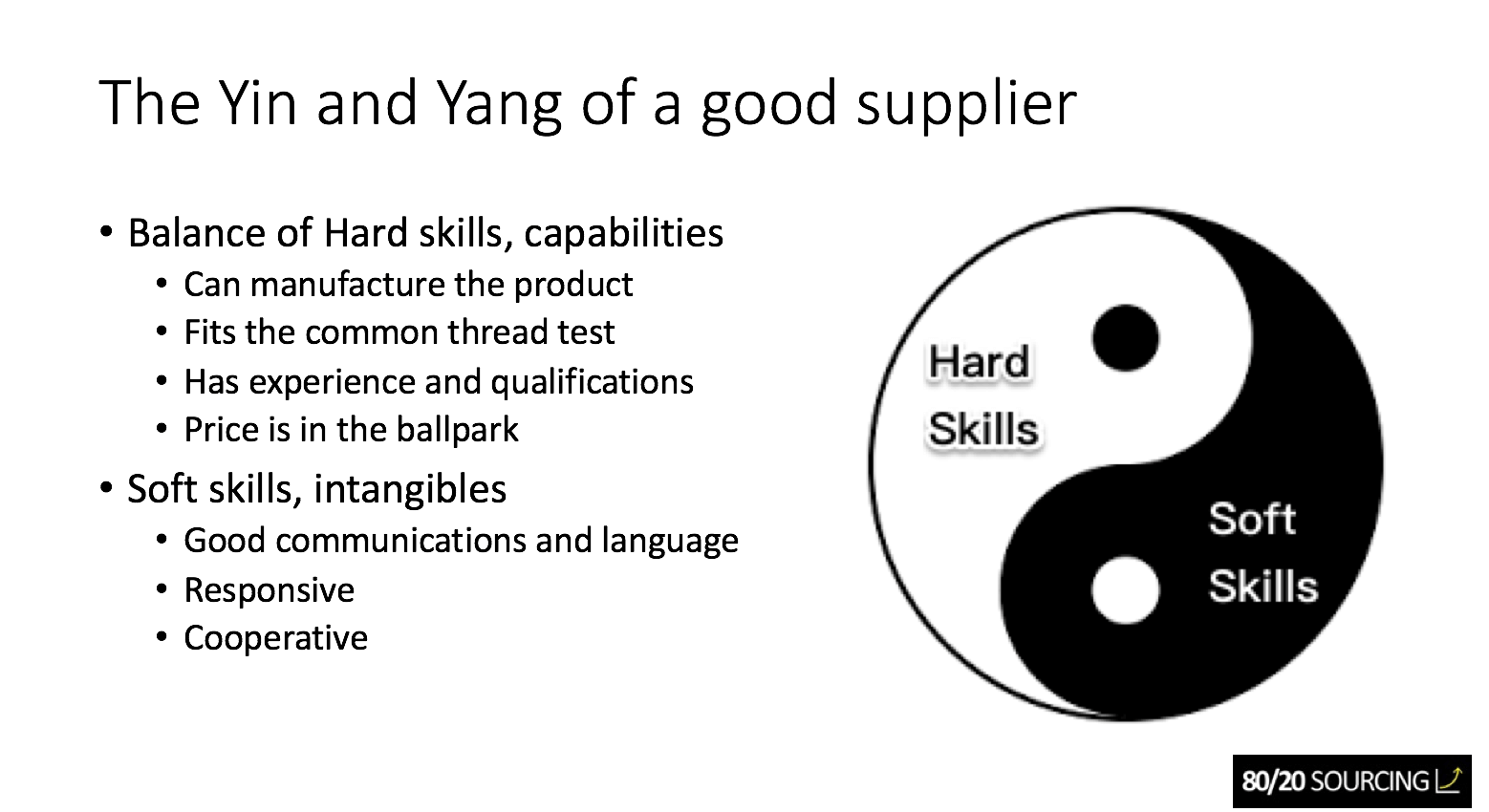
How long has this supplier been listed on Alibaba?
You can see this on an Alibaba listing:
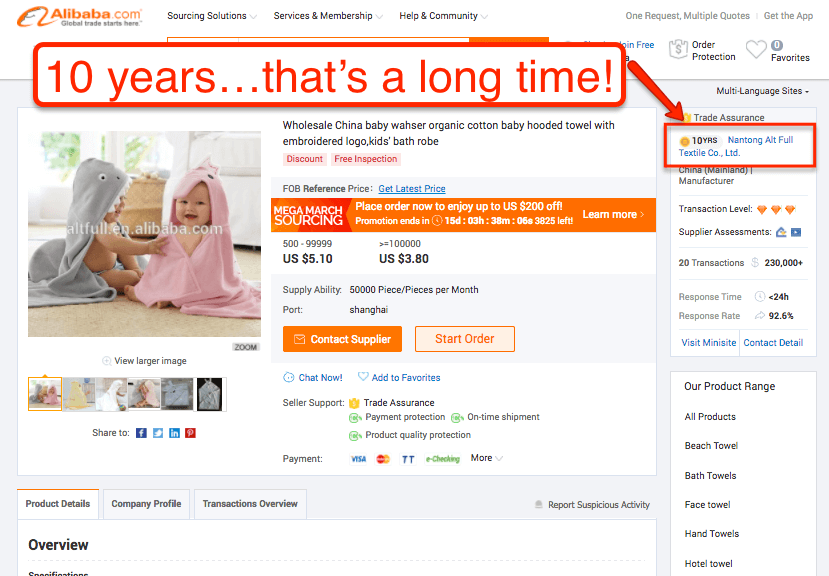
Gary feels more comfortable reaching out to companies that have been around for longer. The number of years is an indication of an established track record, and increases the likelihood of a legitimate supplier.
The Common Thread Test
Gary’s “Common Thread Test” asks a simple question: are the products centered around a common thread?
You want to find a supplier that manufactures the product that you are looking for, and a narrow range of related products. For our search for baby hooded towels, that would mean that towels, textiles, robes, etc would be a relevant fit. If you also see iPhone cases, dog leashes, and water bottles, there is a good chance that this is a trading company that acts as a middleman between you and the supplier.
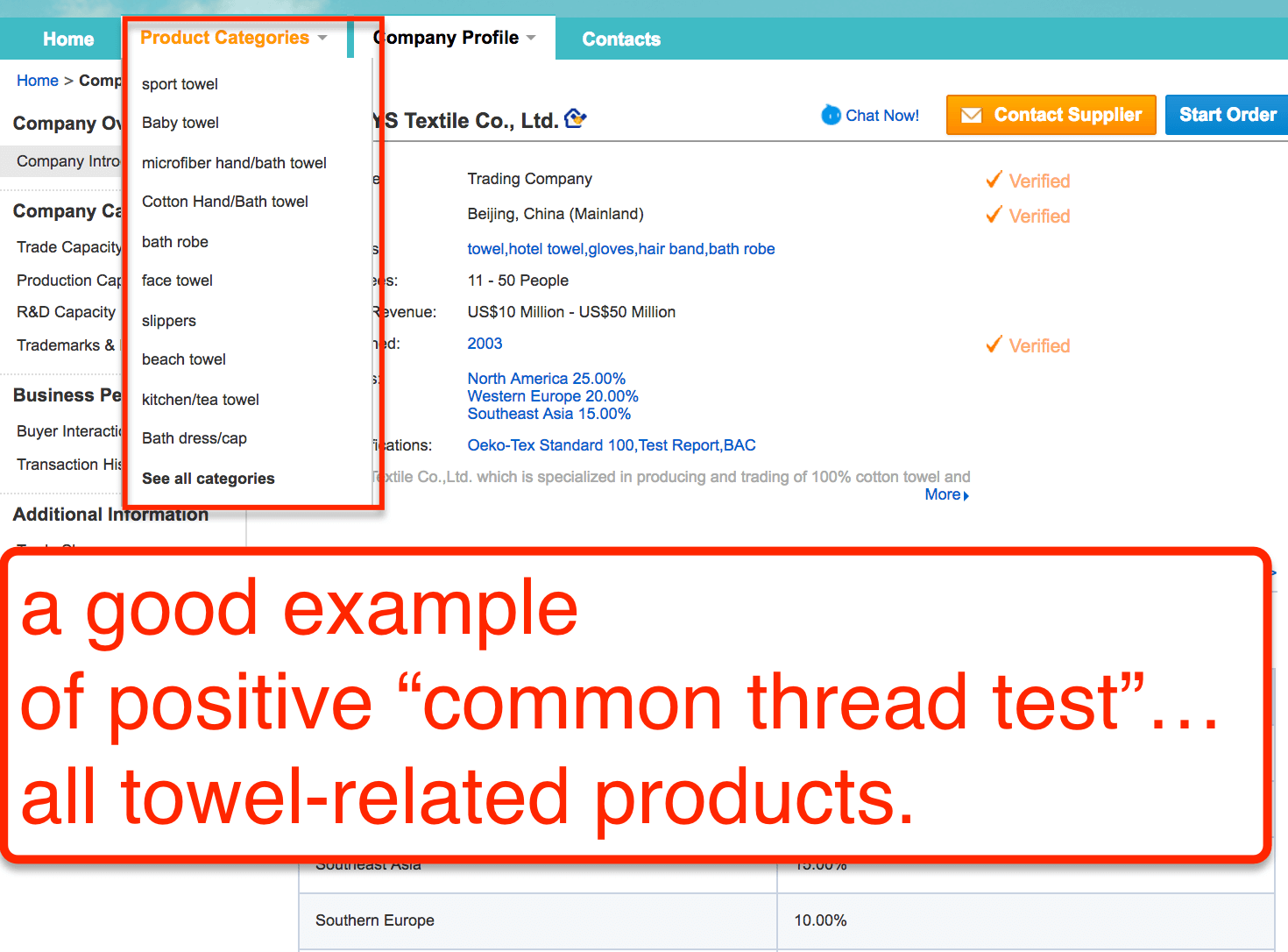
The Country Test
Gary’s “Country Test” asks which countries the supplier exports its products to. The assumption here is that there is a higher quality standard in Europe and North America, and therefore you can expect a higher quality of product from suppliers that export to these regions. If a supplier exports to developing regioins, there may be a poorer product quality.
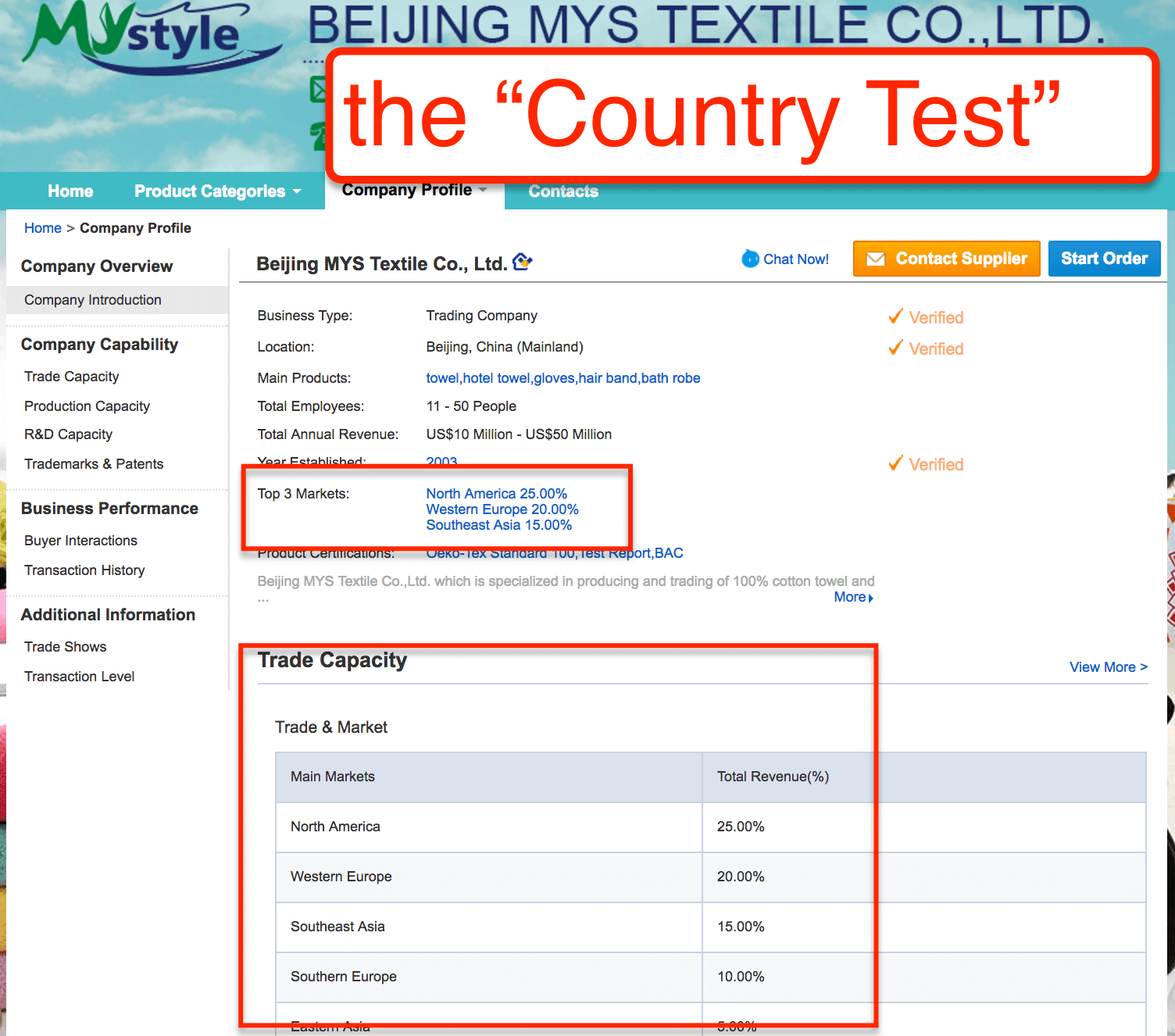
If the suppliers can pass these few criteria, then it is worth reaching out with your initial RFQ template!
Here are few indicators of a “Bad” Supplier:
- Lack of experience – do they not have at least a few years listed on Alibaba? Or not have experience making the type of product that you need? No beuno.
- Pricing is way off – If the pricing is way off from other quotes you receive, either too high or too low, then just walk away. Something is off, better to cut ties quickly.
- If you don’t get any response to your initial RFQ, move on.
- They haven't answered your questions,? Skip them.
- If they appear to be dishonest, move on.
So now let’s follow Gary into the world of Alibaba and see how he finds suppliers who are a good fit:
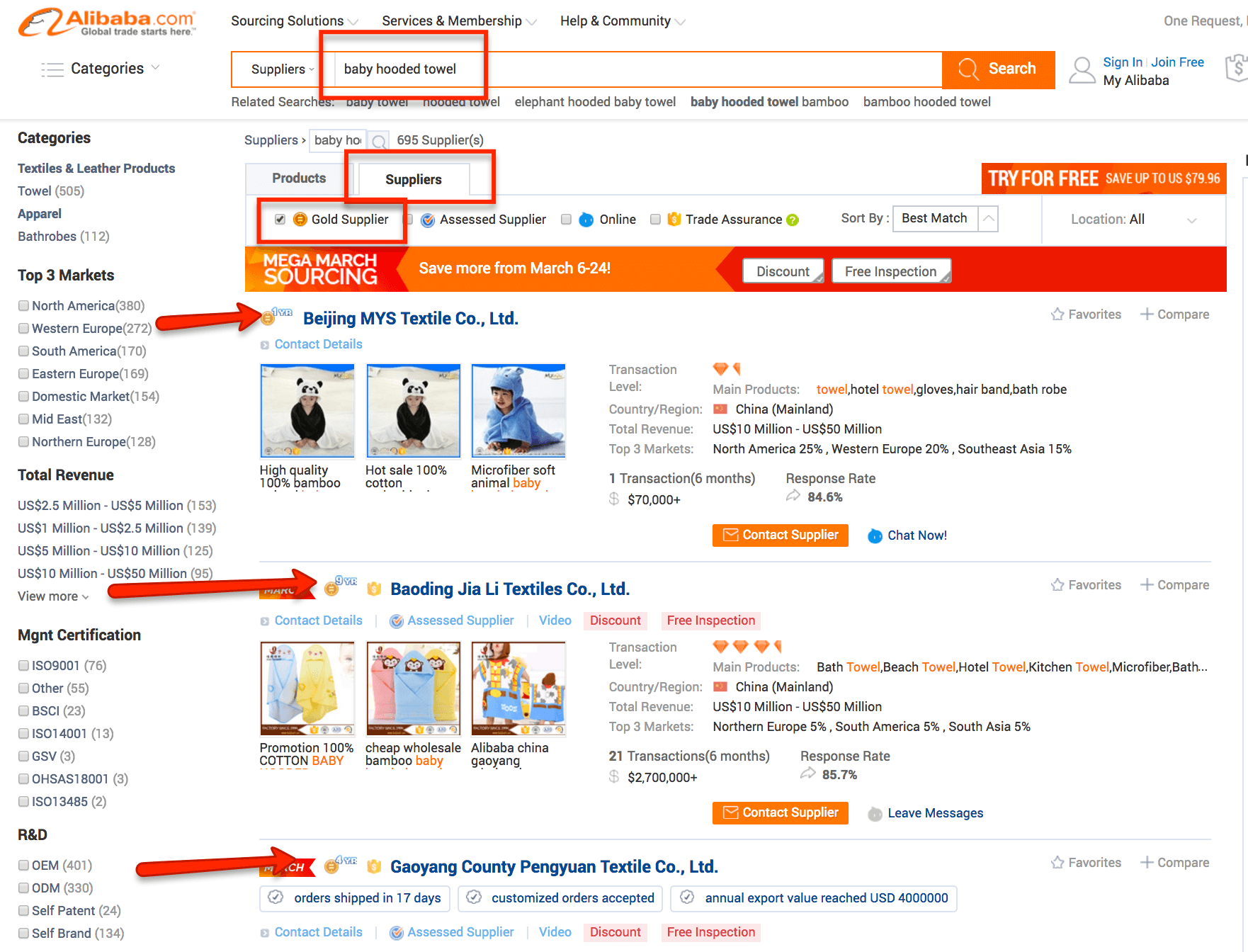
You will initially get a lot of results with just the main keyword, so filter down by searching only those with “Gold Supplier”. Note that suppliers can simply buy a “Gold Supplier” badge so take it with a grain of sale, but it helps to search using this filter as you can also see the number of years in operation.
Track Responses in a spreadsheet:
- Supplier name and location
- Contact person’s name and contact info
- Date RFQ sent and reply
- Price quotation
- Sample cost
- Notes – delivery lead time, other notes
How To Communicate With Suppliers
Communications best practices – communications are the key to good relations!
Gary likes to make Initial contact via Alibaba’s messaging platform. Once you hit “Contact Supplier” in Alibaba's platform, you can simply copy/paste your template and fire it off! But first, don't forget to also include the image attachments to help explain your request in greater detail:
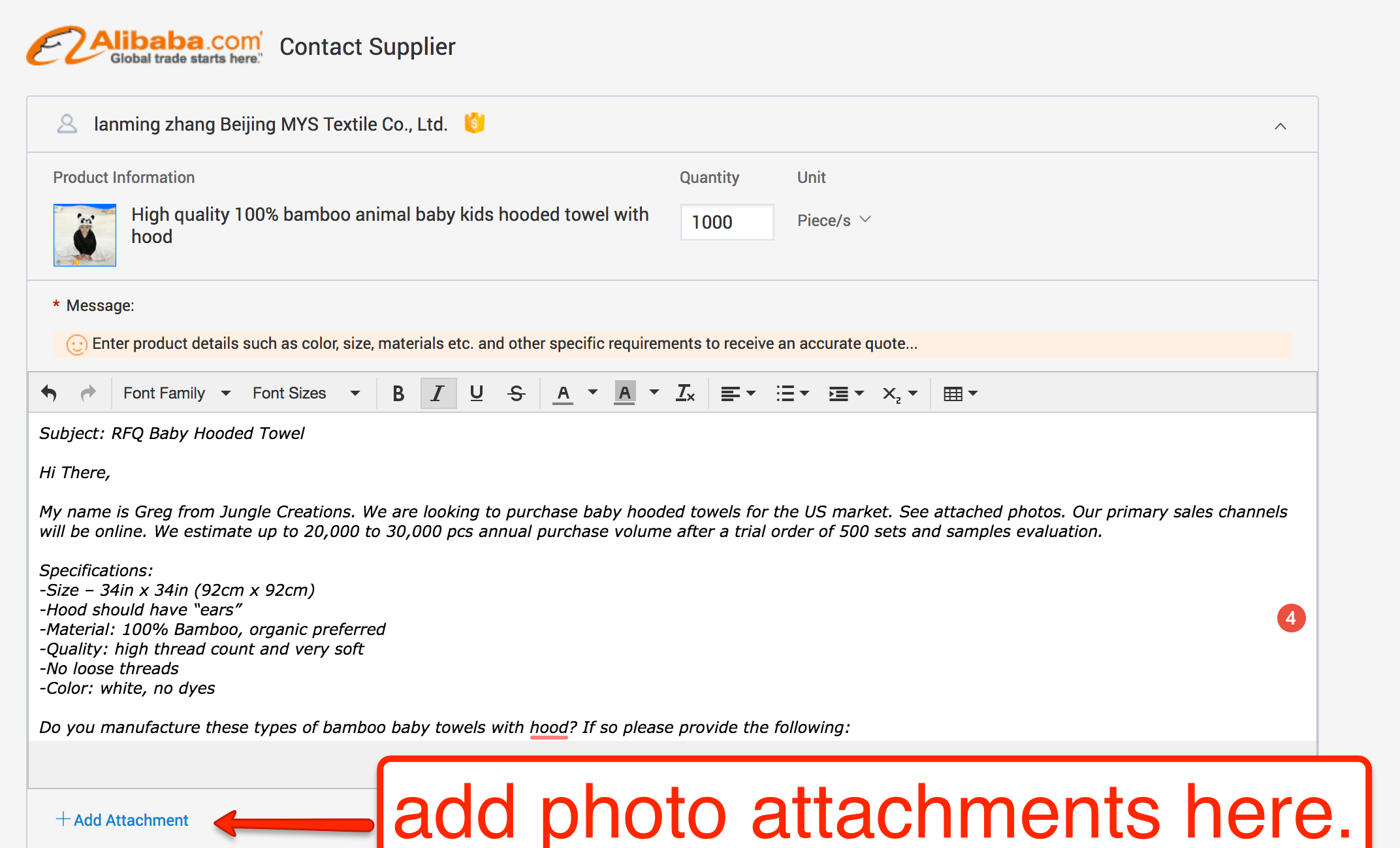
For subsequent communications, he moves to email, as it is easier to track responses and previous conversations.
WeChat is a very popular and helpful option for communicating with Chinese suppliers. It is good for asking quick questions, sending pictures, and videos. Additionally, if there are any problems with a product, WeChat allows for easy video calls to review a product or even do product inspections. Skype is a perfectly viable solution for this as well.
Now Let’s Talk About Money
Gary likes to use Paypal for anything less than $50, like samples. Paypal is not real popular in China, and with processing fees higher in China, the supplier may charge a 5% fee for the time and expenses. It should not be a deal-breaker if they do not accept PayPal, but instead a bonus if it works.
Gary likes to conduct transactions via Bank Transfer, or T/T. It is the most economical, with a $30-$50 fee, though there is limited protection or recourse for paying this method. Once you send the money via T/T, it is very hard to recover it.
One important caveat when paying via T/T: make sure to check that the name on the bank account and the company name are matching! If the supplier doesn’t receive the payment, and the names on the bank account and company name don’t match, there is not much that you can do to recover the payment. That would be upsetting, to say the least!
As far as negotiating payment terms, it is in your advantage to pay as little money upfront as possible. This will reduce your risk, and offer you some leverage to negotiate with the supplier. 30/70 or 50/50 terms are most popular, which means you have to put down a deposit of 30% or 50% to start production. The balance is normally paid when the goods are shipped.
Next Steps
If you want to download additional resources that Gary offered exclusive to the Jungle Scout audience, head to THIS LINK.
Now that we have the exact process and word-for-word script to create a Request for Quotation, it is time dive in to the world of Alibaba…
Greg shared the results of his outreach to suppliers on Wednesday, March 15th. But before that, we held a special episode with Intellectual Property attorney Marc Karish. Marc reviewed the legal steps we will need to consider and investigate before moving forward – check out the full recap and replay here.
Have you missed out on any of the other Million Dollar Case Study sessions? Don't panic – you can still catch full recaps of previous steps in the pursuit to a million dollars right here!
